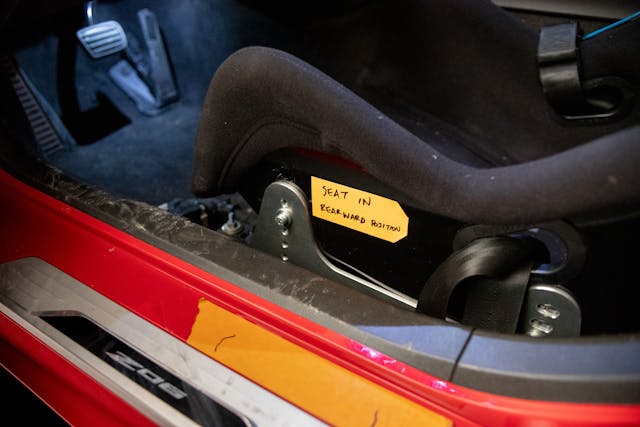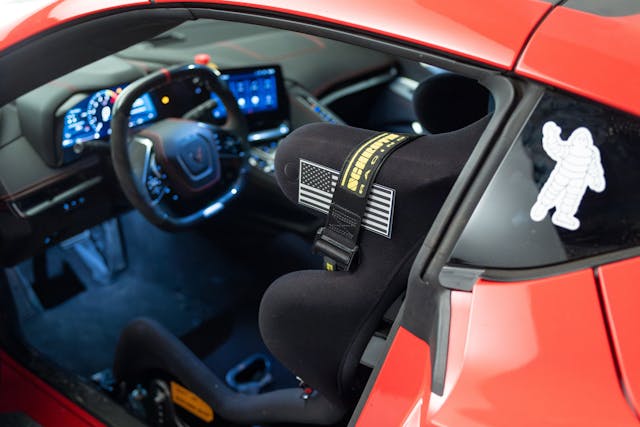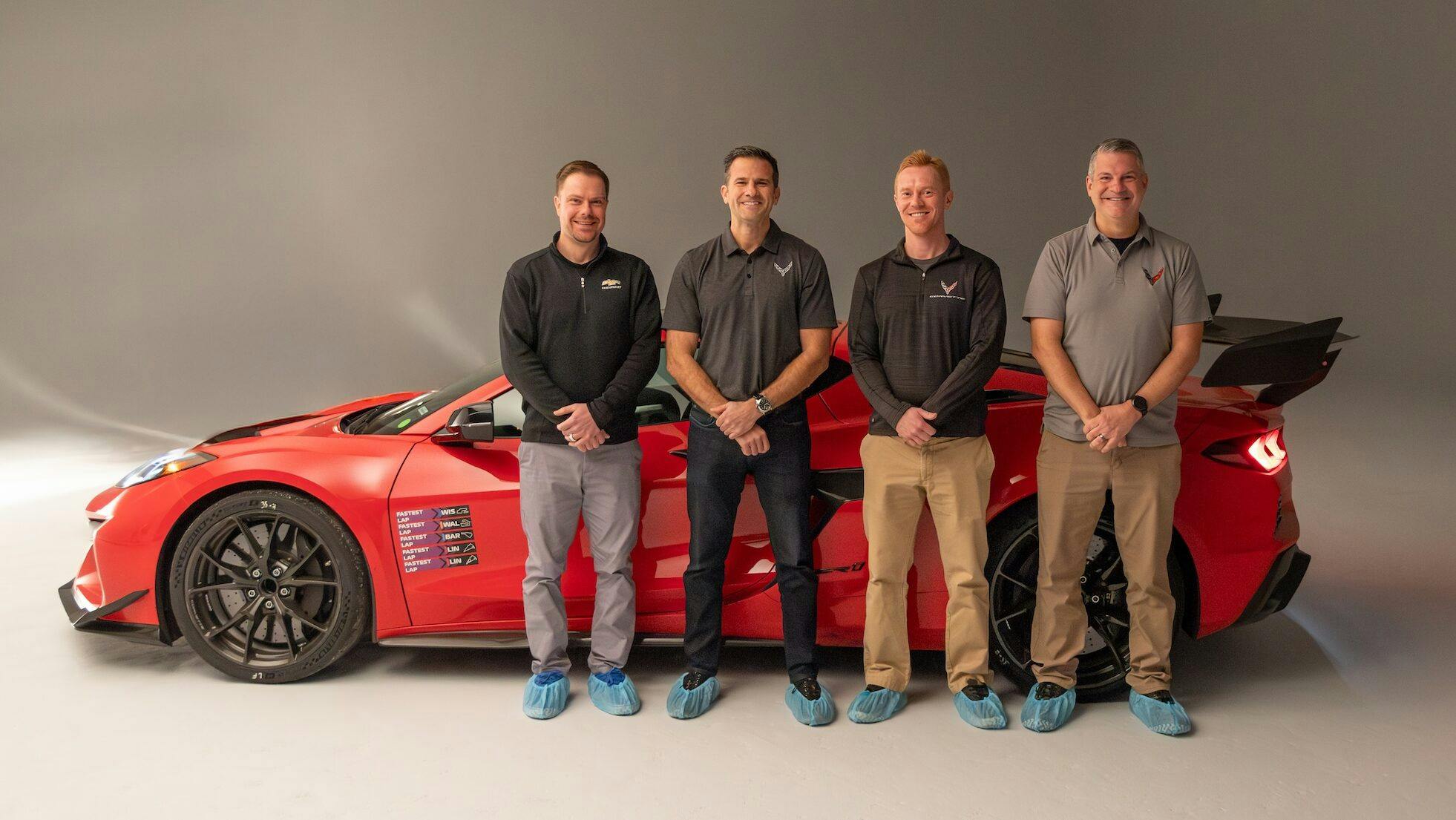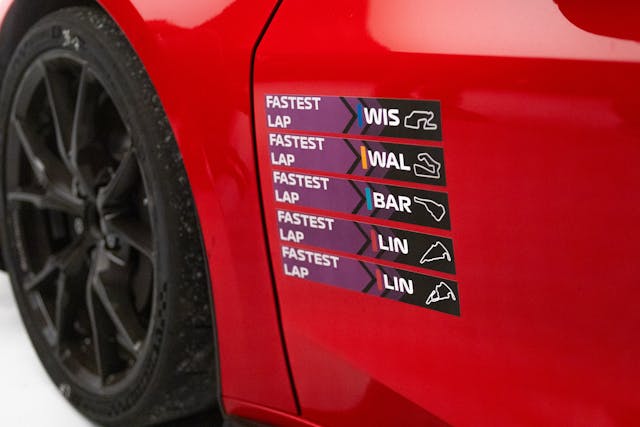Media | Articles
Exclusive Interview: Corvette ZR1 Development Drivers Dish on Their Five U.S. Lap Records
Another day, another bonkers achievement for the 2025 Corvette ZR1. Not content to be the fastest, most powerful Vette ever, Chevrolet aimed its crosshairs at several more superlatives. While in development, the new mid-engine monster flexed its prodigious muscle and remarkable athleticism at four different U.S. tracks, where it claimed five production-car lap records. The C8-generation ZR1 is now King of the Hill at Watkins Glen, Road America, Road Atlanta, and at Virginia International Raceway’s Grand Course as well as its Full Course.
Here are the five courses, along with the record times (all executed in the second half of 2024) and the corresponding GM development driver behind the wheel:
- Watkins Glen Long Course (1:52.7); Driver: Bill Wise, Lead Performance Engineer, Chassis Controls.
- Road America (2:08.6); Driver: Brian Wallace, Lead Vehicle Dynamics Engineer.
- Road Atlanta (1:22.8); Driver: Chris Barber, Lead Development Engineer.
- Virginia International Raceway Full Course (1:47.7); Driver: Aaron Link, Global Vehicle Performance Manager.
- Virginia International Raceway Grand Course (2:32.3); Driver: Aaron Link.
Hagerty sat down with these four development drivers at GM’s Tech Center in Warren, Michigan, for an exclusive interview. In our conversation, the team explained just how extreme the 1064-hp, 828 lb-ft Corvette ZR1 is on track, and how GM goes about the process of chasing lap records in the first place.
But before we get into that discussion, let’s put some of these lap times in perspective. The margins by which the ZR1 claimed these records are measured in seconds, not tenths. At VIR, on the Grand Course, the ZR1’s 2:32.3 lap beat that of the McLaren Senna by 2.6 seconds (set in 2019 at Car and Driver’s Lightning Lap event.) On VIR’s Full Course, the ZR1 bested its predecessor, the 755-hp C7-generation ZR1 from 2019, by 3.5 seconds.
That 1064 hp and bulletproof chassis warped our perception on what fast is.
The previous production car record-holder at Road Atlanta was the 991-generation Porsche 911 GT2 RS, which set a time of 1:24.88 in 2019. The ZR1 beat it by two seconds, and in doing so also surpassed the C7 ZR1’s time by 3.6 seconds. For some really juicy context, consider that the ZR1—a street car—came within five seconds of the Z06 GT3.R race car’s October 2024 Petit Le Mans qualifying time at Road Atlanta. You can see in the accompanying track footage how much this track asks of a car’s braking system, especially when said car has 1064 hp. According to the on-board telematics, there were two sections during which the ZR1 hit 2.0 g of deceleration.
On to Road America and Watkins Glen. At the former, the ZR1’s 2:08.6 lap time put the Corvette more than five seconds (!) ahead of the 992-generation Porsche 911 GT3 RS, which set its record in 2023. It was here at Road America, on the front straight, that the ZR1 hit its top speed at all the tracks: 188 mph. There isn’t much precedent for production-car lap times at Watkins Glen, but the team felt it was important to plant their flag at what they consider one of the nation’s most storied tracks. On this course, the ZR1 saw its highest lateral g, which according to the Chevrolet’s footage peaked at 2.6.
It’s worth noting that the GM hot shoes behind the wheel of these cars are professional engineers, not pro racers, though they all had experience in competition and high-performance environments before joining the company. All four—Link, Wallace, Wise, and Barber—are certified by GM as Level 6 drivers, which is the highest possible internally, and each has Nürburgring Industry Pool certification.
The ZR1 performance development program started two years ago. The true origin of the platform goes back ten years, but once the design team handed off the car to the hardware and development engineers, they hit the ground running. The quartet of wheelmen we spoke with is focused mostly on ride and handling, but the overall division is ultimately looking out for the whole-car experience, down to ironing out every squeak and rattle.
The ZR1’s first stop was home turf: GM’s Milford Proving Grounds. “It was pretty eye-opening at the MRC, the Milford Road Course,” explains Chris Barber, Lead Development Engineer for the ZR1. “On its maiden voyage, its peak speed on our straightaway there was already faster than the previous-gen ZR1. So right out of the gate, it was five or so miles an hour faster. Something around 178 mph. It’s even faster now. And that straightaway is really a bend, the whole way, since MRC is essentially built on a big oval. At those speeds, it’s a max-lat curve.”
If that doesn’t prompt your neck hairs to attention, consider that these test runs were in a pre-production prototype without any traction or stability control. (It was this team’s job to precisely calibrate those systems.) “You’re kind of wheeling it yourself, and it makes turns out of things that have never been turns on our track,” says Aaron Link, Global Vehicle Performance Manager. “You have to kind of set it up and dance on the edge of traction to make sure you don’t track out too early, or too much, in a banked corner. It’s tricky. We realized we kind of outgrew our own track [at MRC].”

The ZR1 was so potent that the first few people to drive it in this early form immediately sought to “rein in” those who got behind the wheel in risky situations. “This car crossed a threshold,” says Link. “We were like ‘holy cow…this requires the most experienced and trustworthy team, and that’s who we have here.”
Link and Bill Wise (Lead Performance Engineer, Chassis Controls) were veterans of the sixth-generation Camaro project, while Barber and Brian Wallace (Lead Vehicle Dynamics Engineer) were part of the C7 and C8 Corvette teams from the beginning. The foursome pitched to management the idea of chasing some high-profile track records, and they got dispensation to do so at four locales—one for each driver.
So, which tracks to target? Wallace points to VIR as a track that pushes you in every possible way. “It has low-speed corners all the way up to 155-mph max lat (lateral g). We focus on tracks that have aero content so we can make sure our aero balance is where we want it. The low-speed stuff really helps for differential integration and ABS integration.”
Road Atlanta and VIR had the practical benefit of warm weather during the fall and winter months when Milford was too cold, and they especially challenge a car with high speeds, high brake power, and high average RPM. But ultimately, for such an exercise, the four tracks were selected because of the opportunity to showcase the ZR1’s ferocity and capability at big-name tracks. Road America and Watkins Glen in particular have a certain historical pedigree with which GM wanted to associate this monumental mid-engine ZR1.
The red Corvette pictured here was used for all four records. It is a pre-production prototype with the ZR1’s ZTK track package: a rear wing, front dive planes, and hood Gurney lip all made of carbon fiber, underbody strakes, stiffer springs, and magnetic ride tuning, and finally, Michelin Pilot Sport Cup 2R ZP tires. The rubber is made from the same compound as the Z06 tires, albeit wrapped around a modified internal carcass and construction that is designed to deal with the ZR1’s higher loads. The car also utilizes Chevy’s optional carbon-fiber wheels.



Aside from a racing seat and a roll bar, the red ZR1 that the development team drove at all four tracks is almost completely factory. The Racetech driver’s seat, wearing an American flag patch on the outer side, is fixed in position with a large metal bracket in a fashion perfected by the Corvette GT3 race crew. Link says that they have never previously needed to include a race seat on prior development cars, but that the lateral forces are so intense in the ZR1 that the “ridiculously stiff seat gives you a good feeling when you’re trying to place the car,” on track. The roll bar is attached at the seat belt anchor and the floor, adding some stiffness but also “a lot of weight,” so Link considers it a fair trade-off.
Other changes include ATE 200 brake fluid (which has a higher boiling point than the factory DOT 4 fluid), and a handful of 3D-printed aero parts, such as the stanchion for the rear wing, but are nevertheless “fully representative” of the production carbon-fiber bits. Barber is especially proud of the fact that the development car ran on ordinary 93-octane pump gas. “There are no games with the fuel at all.”
We used to worry about engine soak, ambient soak temperatures, or running the car from cold for top performance. This engine doesn’t give a shit.
In terms of setup, GM prepped the record-setting Corvette ZR1 according to the same track supplement guide that every customer will get in their owner’s manual. Aerodynamics are fixed, but the camber, caster, toe, and ride height are all adjustable. The window of optimal track performance, however, given the huge tires and immense power, is fairly narrow and not wildly different from the street specification. Here’s Link again: “A lot of people on the outside think, ‘well I’ve got to go to four degrees of camber to get the max out of this car,’ but that hurts the shoulders of the tires too much. And then you end up kind of on the inside edge of the tire and not using their full capability.”

The development team thus paid a lot more attention to ambient temperature, track temperature, optimal tire temperature, and optimal tire pressure, all of which varied from track to track. “Because each track is of different length, you’ll get tire temps peaking at different ranges,” explains Wise. “So we’ll play some games with tire pressures when chasing a lap time—starting pressures—to get to the peak when we want it.”
Experts from Michelin were on hand to monitor these factors, and at times they used racing-style tire warmers to reach ideal starting temperatures for the tires.
All four drivers achieved their records with the ZR1’s Performance Traction Management (PTM) traction and stability control system set to Mode 5, or Race. In this setting, which elicits the most performance out of the car, stability control is off but traction control is on. That means the ZR1 won’t help if you put it into a spin, but it does assist with putting down power to optimize off-corner launches and acceleration. “With 1064 hp, even when you try not to engage PTM, you still do,” notes Wallace. “Especially in the early stages of development, the car just stepped out a lot. We tuned it such that when you get to the middle of the corner and you’re ready to accelerate, you just put it to the floor and let the computer do the work. Then you just steer yourself off the corner.”
Marketplace
Buy and sell classics with confidence
Any rotation that the car permits in these situations is there to let the car go faster and ultimately optimize lap times, qualifies Barber. But the driver still needs to counter-steer, and all of this is happening absurdly quickly. All four drivers likened the ZR1 experience to a Z06 “on fast-forward.”
Benchmark cars for the ZR1’s development, aside from the C8 Stingray Z51 and Z06, were the outgoing C7 ZR1 as well as the Porsche 911 GT2 RS. The team also used track data and onboard footage (rather than any live testing) from the 911 GT3 RS and Corvette GT3 race car. GM’s state-of-the-art simulator loop at Milford can represent the C8.R IMSA car, which also helped the team prepare for their track outings.
The GT2 RS came with them to various circuits, where the Corvette team was impressed by its track prowess. On public roads, however, the car’s weaknesses became clearer, Barber tells us. “You’d think everyone would be clamoring to drive the GT2 RS, but afterward nobody wanted to drive that car on the street again, because it’s so compromised.” Link points to the car’s Heim joints (rather than traditional rubber bushings) as one culprit, contributing to higher road input and cabin noise.
The ZR1’s high aerodynamic downforce was of particular use at Watkins Glen, says Wise, where average track speed is high but top speed is less important than at the other three tracks. When given the opportunity to really stretch the car’s legs, however, the team was blown away by its acceleration in higher gears and monster torque, which peaks at just 3000 rpm.
“The kink at Road Atlanta—coming down the hill to the brake zone and into turn 10—that was a different experience,” Barber recalls. “That’s what kind of what made me say ‘holy shit,’ because you’re clicking into sixth year at 178 mph there and you still have to make it around the corner and figure out where you’re going to brake. That’s really the kind of experience you see in IMSA cars. We’ve had plenty of fast cars at this company before, and capable ones, but this takes it to a different level of how it punches through the air in fourth and fifth gear. Just relentless power.“
Compared with the naturally aspirated Z06, which thrives at higher rpm, Link explains, the ZR1 hardly ever needs to be in anything below third gear. With the turbos it generates 37 pounds of max thrust simply from the air running through the muffler. If you could apply that force to a ZR1 on a flat surface, with the transmission in neutral, it would be enough to move the car, says Link.
That 1064 hp and bulletproof chassis “warped our perception on what fast is,” says Wise. “You carry a bunch of commitment into the corner, pile it in, and you’re doing a higher max lat than you’ve ever done before and now you’ve got double the power you’re used to on the exit.”

Durability was never a problem, either, according to Link:
“We used to worry about engine soak, ambient soak temperatures, or running the car from cold for top performance. This engine doesn’t give a shit. We’d think, ‘Should we cool it? Should we put fans on it? Should we at least pop the hatch while we’re waiting between runs?’ The ZR1 didn’t care. You could watch the top speed on every lap you did and it was the same. The cooling is so good, and the capability of the engine is such that it doesn’t have to be tuned to the knife edge of spark knock.”
The beauty of the ZR1, the development team says, is that all of this performance doesn’t come at the expense of approachability, even on the street. Fourth-gen magnetic ride suspension is the secret there, along with an incredibly stiff structure, allowing the driver to “have their cake and eat it too,” in terms of balancing performance with livability.
As we end our conversation, Link wants to stress that the ZR1 is a homegrown marvel. It seems to be a subtle dig at Ford, which partners with Multimatic to produce the $325,000+ Mustang GTD. “We’re real proud that this car is engineered here in Michigan and built in Kentucky. We don’t farm any of this out to outside companies. Our connection with Pratt and Miller obviously is big, but this was all us.”















Not a bunch of smiles more proud, anywhere! That’s impressive; some lucky guys have all the fun!
Laguna Seca? Circuit of the Americas?
I was thinking Laguna Seca as well, and maybe Sonoma.
All fine and good, but the ultimate test is in Germany where the Nurburgring awaits the ZR1’s arrival.
They’ve already been, albeit on industry pool days with other OEMs at the same time. They told me the ZR1’s closing speeds are “pretty insane” though they wouldn’t say anything about lap times when pressed. I’d wager they’ll take a go at a record sooner than later, if they haven’t already done so.
They already tried for a record time at Nurburgring and were not fast enough.
Agreed!
I wouldn’t lose any sleep over it. That sounds like a very determined group.
Great! Of course, Chevrolet won’t sell you a ZR-1 since they are for YouTubers. Corvette people, even if they have been a long time Vette customer, are being told, “Sorry!”
Watching the track videos is just fun to see everything whip by so quickly and cleanly. I’ll never afford one.
It will be interesting to see if the ZR1 beats the Mustang on the the Nurburgring, if as said above the Corvette is already there – maybe they haven’t broken the 7 minute barrier yet. In any event, an incredible machine. Keep in mind Ford doesn’t have the deep pockets of GM. What a job each of those guys have.
Indeed. One thing they shared though is that record chasing like this is something that happens only a handful of times in a career as a development driver. The overwhelming majority of the time they’re on track is specifically to bring back feedback that engineers can use to improve the car. The four drivers take a lot of pride in their ability to “speak with one voice” to their colleagues and hopefully shape a driving experience that can satisfy each of their driving styles, and thus as many buyers as possible.
The Mustang time needs an asterisk. It is a limited edition race car that is barley legal and twice the price of the ZR1.
Not exactly something you can drive daily like the ZR.
And for all those pining about not being able to afford one. The Stingray is the same car with less power but just as rewarding to drive on the streets. These are now on the used market and should be available to most.
As for working on. Mid engine is no more difficult. The engines drop out like the C5-7 via the bottom. You may have to drop it to do the water pump but you will not have to drop the drive line torque tube rear and exhaust for the clutch.
I was afraid of my C5 till I got to know it and nothing is all that difficult.
Records are great but sales are important.
FYI Porsche sent a message to GM and advised them they tested the ZR1 and advised they got it right. That speaks volumes.
The Zora is next. I am getting vibes it may be a modern day Grans Sport. There is a lot of media coverage ont he Grand Sports of 1963. This to me is going to be a real track focused car like Zora wanted back in the day. Lighter and more power. They said the cost will not be more than the ZR1. They said the Z was the most expensive model unless something has changed,.
As a resident of the Finger Lakes region, it was great to hear them honoring Watkins Glen and its rich racing history.
Is Chris Barber a relation to Skip Barber?
“We were like ‘holy cow…this requires the most experienced and trustworthy team, and that’s who we have here.”
Did they accidentally forget about Mark Reuss?